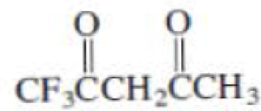
EBK CHEMISTRY
12th Edition
ISBN: 8220102797857
Author: Chang
Publisher: YUZU
expand_more
expand_more
format_list_bulleted
Concept explainers
Textbook Question
Chapter 23, Problem 23.67QP
The compound 1,1,1-trifluoroacetylacetone (tfa) is a bidentate ligand:

It forms a tetrahedral complex with Be2+ and a square-planar complex with Cu2+. Draw structures of these complex ions and identify the type of isomerism exhibited by these ions.
Expert Solution & Answer
Want to see the full answer?
Check out a sample textbook solution
Students have asked these similar questions
True or false, chemistry
answer thse questions with mechanisms and steps. handwritten please!
C
app.aktiv.com
Draw the product of the following reaction sequence. Ignore
any inorganic byproducts formed.
H
O
1. (CH3CH2)2CuLi, THF
2. CH3Br
Drawing
Chapter 23 Solutions
EBK CHEMISTRY
Ch. 23.1 - Identify the following transition metal atoms and...Ch. 23.3 - What is the difference between these two...Ch. 23.3 - Write the oxidation numbers of the metals in the...Ch. 23.3 - Prob. 2PECh. 23.3 - Prob. 3PECh. 23.3 - Prob. 2RCCh. 23.4 - Prob. 1RCCh. 23.5 - Prob. 4PECh. 23.5 - Prob. 1RCCh. 23 - What distinguishes a transition metal from a...
Ch. 23 - Why is zinc not considered a transition metal?Ch. 23 - Explain why atomic radii decrease very gradually...Ch. 23 - Without referring to the text, write the...Ch. 23 - Write the electron configurations of the following...Ch. 23 - Why do transition metals have more oxidation...Ch. 23 - Prob. 23.7QPCh. 23 - Prob. 23.8QPCh. 23 - Define the following terms: coordination compound,...Ch. 23 - Describe the interaction between a donor atom and...Ch. 23 - Prob. 23.11QPCh. 23 - Prob. 23.12QPCh. 23 - Prob. 23.13QPCh. 23 - Prob. 23.14QPCh. 23 - Prob. 23.15QPCh. 23 - What are the systematic names for the following...Ch. 23 - Prob. 23.17QPCh. 23 - Prob. 23.18QPCh. 23 - Define the following terms: stereoisomers,...Ch. 23 - Prob. 23.20QPCh. 23 - Prob. 23.21QPCh. 23 - Prob. 23.22QPCh. 23 - Prob. 23.23QPCh. 23 - Prob. 23.24QPCh. 23 - Draw structures of all the geometric and optical...Ch. 23 - Prob. 23.26QPCh. 23 - Briefly describe crystal field theory.Ch. 23 - Prob. 23.28QPCh. 23 - What is the origin of color in a coordination...Ch. 23 - Prob. 23.30QPCh. 23 - Prob. 23.31QPCh. 23 - Prob. 23.32QPCh. 23 - Prob. 23.33QPCh. 23 - Prob. 23.34QPCh. 23 - Prob. 23.35QPCh. 23 - The absorption maximum for the complex ion...Ch. 23 - Prob. 23.37QPCh. 23 - A solution made by dissolving 0.875 g of...Ch. 23 - Prob. 23.39QPCh. 23 - Prob. 23.40QPCh. 23 - Prob. 23.41QPCh. 23 - The [Fe(CN)6]3 complex is more labile than the...Ch. 23 - Aqueous copper(II) sulfate solution is blue in...Ch. 23 - When aqueous potassium cyanide is added to a...Ch. 23 - A concentrated aqueous copper(II) chloride...Ch. 23 - Prob. 23.46QPCh. 23 - As we read across the first-row transition metals...Ch. 23 - Prob. 23.48QPCh. 23 - Prob. 23.49QPCh. 23 - Prob. 23.50QPCh. 23 - Prob. 23.51QPCh. 23 - Chemical analysis shows that hemoglobin contains...Ch. 23 - Explain the following facts: (a) Copper and iron...Ch. 23 - A student in 1895 prepared three coordination...Ch. 23 - Prob. 23.55QPCh. 23 - From the standard reduction potentials listed in...Ch. 23 - Using the standard reduction potentials listed in...Ch. 23 - The Co2+-porphyrin complex is more stable than the...Ch. 23 - Prob. 23.59QPCh. 23 - Prob. 23.60QPCh. 23 - Hydrated Mn2+ ions are practically colorless (see...Ch. 23 - Which of the following hydrated cations are...Ch. 23 - Prob. 23.63QPCh. 23 - Prob. 23.64QPCh. 23 - Prob. 23.65QPCh. 23 - Prob. 23.66QPCh. 23 - The compound 1,1,1-trifluoroacetylacetone (tfa) is...Ch. 23 - Prob. 23.68QPCh. 23 - Prob. 23.69QPCh. 23 - Prob. 23.70QPCh. 23 - Prob. 23.71QPCh. 23 - Commercial silver-plating operations frequently...Ch. 23 - Draw qualitative diagrams for the crystal field...Ch. 23 - (a) The free Cu(I) ion is unstable in solution and...Ch. 23 - Prob. 23.75QPCh. 23 - Prob. 23.76QP
Knowledge Booster
Learn more about
Need a deep-dive on the concept behind this application? Look no further. Learn more about this topic, chemistry and related others by exploring similar questions and additional content below.Similar questions
- Complete the mechanismarrow_forwardV Biological Macromolecules Drawing the Haworth projection of an aldose from its Fischer projection Draw a Haworth projection of a common cyclic form of this monosaccharide: H C=O HO H HO H H OH CH₂OH Explanation Check Click and drag to start drawing a structure. Xarrow_forwardComplete the mechanismarrow_forward
arrow_back_ios
SEE MORE QUESTIONS
arrow_forward_ios
Recommended textbooks for you
 Chemistry: Principles and ReactionsChemistryISBN:9781305079373Author:William L. Masterton, Cecile N. HurleyPublisher:Cengage Learning
Chemistry: Principles and ReactionsChemistryISBN:9781305079373Author:William L. Masterton, Cecile N. HurleyPublisher:Cengage Learning Principles of Modern ChemistryChemistryISBN:9781305079113Author:David W. Oxtoby, H. Pat Gillis, Laurie J. ButlerPublisher:Cengage Learning
Principles of Modern ChemistryChemistryISBN:9781305079113Author:David W. Oxtoby, H. Pat Gillis, Laurie J. ButlerPublisher:Cengage Learning Chemistry: The Molecular ScienceChemistryISBN:9781285199047Author:John W. Moore, Conrad L. StanitskiPublisher:Cengage Learning
Chemistry: The Molecular ScienceChemistryISBN:9781285199047Author:John W. Moore, Conrad L. StanitskiPublisher:Cengage Learning Chemistry: Principles and PracticeChemistryISBN:9780534420123Author:Daniel L. Reger, Scott R. Goode, David W. Ball, Edward MercerPublisher:Cengage Learning
Chemistry: Principles and PracticeChemistryISBN:9780534420123Author:Daniel L. Reger, Scott R. Goode, David W. Ball, Edward MercerPublisher:Cengage Learning ChemistryChemistryISBN:9781305957404Author:Steven S. Zumdahl, Susan A. Zumdahl, Donald J. DeCostePublisher:Cengage Learning
ChemistryChemistryISBN:9781305957404Author:Steven S. Zumdahl, Susan A. Zumdahl, Donald J. DeCostePublisher:Cengage Learning Chemistry: An Atoms First ApproachChemistryISBN:9781305079243Author:Steven S. Zumdahl, Susan A. ZumdahlPublisher:Cengage Learning
Chemistry: An Atoms First ApproachChemistryISBN:9781305079243Author:Steven S. Zumdahl, Susan A. ZumdahlPublisher:Cengage Learning

Chemistry: Principles and Reactions
Chemistry
ISBN:9781305079373
Author:William L. Masterton, Cecile N. Hurley
Publisher:Cengage Learning

Principles of Modern Chemistry
Chemistry
ISBN:9781305079113
Author:David W. Oxtoby, H. Pat Gillis, Laurie J. Butler
Publisher:Cengage Learning

Chemistry: The Molecular Science
Chemistry
ISBN:9781285199047
Author:John W. Moore, Conrad L. Stanitski
Publisher:Cengage Learning

Chemistry: Principles and Practice
Chemistry
ISBN:9780534420123
Author:Daniel L. Reger, Scott R. Goode, David W. Ball, Edward Mercer
Publisher:Cengage Learning

Chemistry
Chemistry
ISBN:9781305957404
Author:Steven S. Zumdahl, Susan A. Zumdahl, Donald J. DeCoste
Publisher:Cengage Learning

Chemistry: An Atoms First Approach
Chemistry
ISBN:9781305079243
Author:Steven S. Zumdahl, Susan A. Zumdahl
Publisher:Cengage Learning
The Bohr Model of the atom and Atomic Emission Spectra: Atomic Structure tutorial | Crash Chemistry; Author: Crash Chemistry Academy;https://www.youtube.com/watch?v=apuWi_Fbtys;License: Standard YouTube License, CC-BY